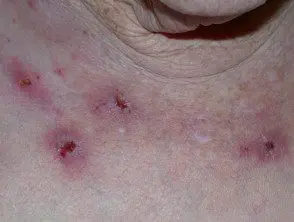What is it compulsive picking the skin?
Compulsive skin picking is a disorder characterized by repetitive picking at one's skin to the point of causing open sores that can bleed and leave scars. This condition is also known as dermatillomania, pathological and neurotic skin needling. excoriation.
People who suffer from compulsive skin itching may detect normal skin variations such as freckles and moles, pre-existing skin blemishes such as scabs, sores, or acne blemishes, or, in some cases, imagined skin blemishes that others don't. you can see. People with compulsive skin picking not only use their fingernails for scratching and scratching, but may also use their teeth and/or other instruments such as tweezers, blades, and pins. The compulsion to scratch, pick or peel pimples is called acne excorié and could be considered a subtype of compulsive skin picking. Although any part of the body can be attacked, often the face is the target area.
Compulsive collection of the skin.

Compulsive collection of the skin.

Compulsive collection of the skin.

Compulsive collection of the skin.
See more images of compulsive skin.
What causes compulsive skin picking?
People with compulsive skin picking often have coexisting psychiatric disorder. The most common coexisting psychiatric conditions are major depression and anxiety disorders, especially hauntingcompulsive disorder (OCD). In one study, the 52% of compulsive skin picking patients were also diagnosed with OCD. An organic disease anemia, uremia or liver disease can also cause compulsive itching of the skin. It is essential that the doctor consider all possible causes.
In many patients with compulsive skin picking, the skin picking is preceded or accompanied by a high level of tension, anxiety, or stress and a strong urge to itch or scratch. Often certain events or situations trigger harrowing episodes. For some, the act of touching the skin provides a sense of relief or pleasure. Skin-needling episodes may be a conscious response to anxiety or may be done as an unconscious habit.
Compulsive skin picking appears to be more common in women than men, often beginning in adolescence.
It can also be associated with methamphetamine or cocaine abuse.
What are the effects of compulsive skin picking?
Skin damage caused by compulsive needling can range from mild to extreme. Bleeding, bruising, and secondary infections are not uncommon. In severe cases, patients can create wounds so large that they require hospital care. Compulsive skin needling often leads to permanent disfigurement, embarrassment, and social impairment. Victims will often try to hide the damage done to their skin by using makeup and/or clothing to cover the marks and scars. In extreme cases, they will avoid social situations to hide their condition from those around them.
What treatment is available?
Treatment for compulsive skin needling depends on the cause and the patient's level of awareness of the problem. Compulsive skin picking stemming from a psychological disorder is best treated with psychotherapy. When compulsive skin picking is usually an unconscious habit, the treatment of choice is a form of cognitive behavioral therapy called Habit Reversal Training (HRT).
Psychological treatments
Habit Reversal Training: This is a form of psychotherapy that helps patients become more aware of the situations and events that trigger episodes of itchy skin. Patients are then taught alternative behaviors in response to these situations and events.
Exposure and response prevention (ERP): This is commonly used in the treatment of obsessive-compulsive disorders and is useful in cases of compulsive skin needling where the patient is already aware of the situations and events that cause needling episodes. Most of the patients using this technique have already recovered significantly with HRT.
Pharmacological treatments
Medications used for the treatment of OCD are also frequently used in compulsive skin picking. They are often used in conjunction with cognitive behavioral therapy. The drugs of choice are selective serotonin reuptake inhibitors (SSRIs) such as fluoxetine, paroxetine, sertraline, and fluvoxamine. Acetylcysteine has also been reported to be effective.

